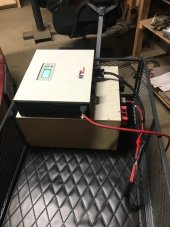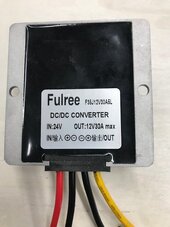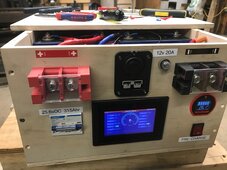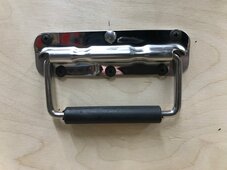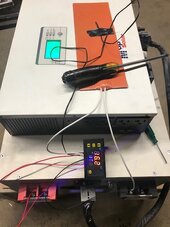OffGridForGood
Catch, make or grow everything you can.
I wanted to share some of the work I have done on my mobile 24v system.
Yes @EastTexCowboy You are my inspiration for this!
First up, the base of the system is my MPP 2724 AIO inverter. This unit is unique among all the All In One inverters that I know, as it is the only one I came across that has 20 amp outlets (plus two USB) Built Right into the side of the Inverter.
This is very handy for a mobile set up, since it saves you the bother of adding a power bar, and it is nice and neatly part of the inverter case.
So this is the battery build section - lets see a DIY battery:
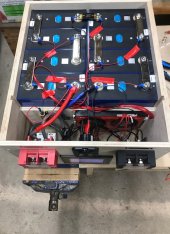
This is a set of eight Envision 315Ah cells set in twin rows, with a fuse between cell #4 and #5 at the turn (rear of the pack, top of the pic) controlled with a Daly 150A 8S BMS. The Daly was available with a 4.3" screen and activation button so what the heck, just install that for quick info and setting changes with the touch screen. The wiring could be more neatly organized but oh well it looks good with the lid on.
I used the peal and stick type of separator sheets made from 'fish paper' (funny green looking thick paper you see in lots of electonic equipment) and foam between the centre row to hold the cells from moving around. They are not technically 'under compression' but when fully charged they are very firmly set. The Fuse at the rear of the pack is 200 Amp ANL and is an idea one of the members passed on to me, if ever a dead short takes place this fuse will cut the pack into two 12 volt halves and break the circuit. A class T wasn't going to fit the cells, and if required could be used on the exterior of the battery at the through terminals.
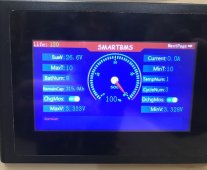
The touch screen is very easy to use, just touch the parameter you want to adjust, and a menu pops up, type in the change and hit SET. Done.
The settings are not adjusted in the picture, yeah took the pic before changing the settings to see if any Eagle Eyed members can spot the setting errors like the 180A charging current setting. ya got me!
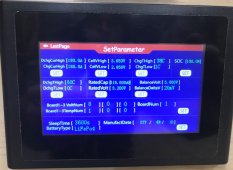
You can easily scroll through the menu and see cell voltages without an I-phone or wifi being required. These cells have only done a few cycles however they are close to a balance with about 6mv delta. If I need to adjust that one low cell, a few screws opens the lid of the case and gives me access to adjust cells with a bench top charger, or an automotive bulb depending which way we are trying to go.
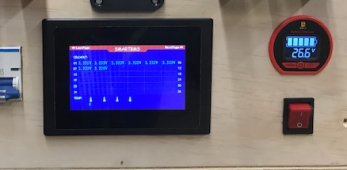
Since this is my mobile set up, I didn't really want to be messing with bolting on battery cables and then taking them off again to move the battery and inverter separately. The battery is about 100 lbs (45kg) and that is enough to move on it's own, then I can move the inverter and set these up in a garden wagon or in my truck - even on the back of the quad. To make the battery connection easy I used an Anderson plug wired with 4AWG cables in the battery case.
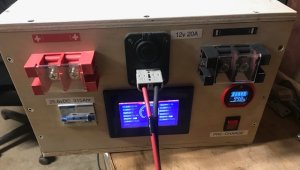
The Anderson plug is "24 volt" ie 8s is about 25.6 volt nominal for the inverter, I liked the idea of a 12 volt plug too for things like USB adapter or a few things I have from my truck like a trouble light, tire pump and phone charger that all fit this 12 volt outlet - so used this handy Anderson & 12 volt plug from Aliexpress. I installed the bigger through-case battery terminals as well for two reasons: one, so I can have the full 150A capacity of the battery when I need it, and two so I can put a second battery in parallel with this one using the double terminals.
The inverter needs the capacitors pre-charged so I installed a 2P rocker switch in the bottom right of this photo, connected to the neg after the BMS and connected to the Pos via a 50W 100 ohm resistor. With the main 2P 125A breaker (on the left of the photo) off, the pre-charge switch allows 24 volt via the resistor to pre-charge the inverter before switching on the main breaker.
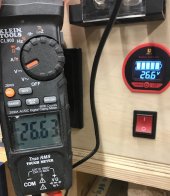
The pre-charge takes 30 seconds to pre-charge the caps, then flip the main breaker and turn off the pre-charge.
The activation button also shows either the SOC or the voltage - user selected. The touch screen also has a wake-up button but this looked fine above the pre-charge and it is quick and easy way to spot the SOC even from a distance.
I have been using these cells for a couple months now, but the case was only just assembled. Next up: setting up the garden cart for the battery and inverter. Stay tuned. More to follow.
Yes @EastTexCowboy You are my inspiration for this!
First up, the base of the system is my MPP 2724 AIO inverter. This unit is unique among all the All In One inverters that I know, as it is the only one I came across that has 20 amp outlets (plus two USB) Built Right into the side of the Inverter.
This is very handy for a mobile set up, since it saves you the bother of adding a power bar, and it is nice and neatly part of the inverter case.
So this is the battery build section - lets see a DIY battery:

This is a set of eight Envision 315Ah cells set in twin rows, with a fuse between cell #4 and #5 at the turn (rear of the pack, top of the pic) controlled with a Daly 150A 8S BMS. The Daly was available with a 4.3" screen and activation button so what the heck, just install that for quick info and setting changes with the touch screen. The wiring could be more neatly organized but oh well it looks good with the lid on.
I used the peal and stick type of separator sheets made from 'fish paper' (funny green looking thick paper you see in lots of electonic equipment) and foam between the centre row to hold the cells from moving around. They are not technically 'under compression' but when fully charged they are very firmly set. The Fuse at the rear of the pack is 200 Amp ANL and is an idea one of the members passed on to me, if ever a dead short takes place this fuse will cut the pack into two 12 volt halves and break the circuit. A class T wasn't going to fit the cells, and if required could be used on the exterior of the battery at the through terminals.

The touch screen is very easy to use, just touch the parameter you want to adjust, and a menu pops up, type in the change and hit SET. Done.
The settings are not adjusted in the picture, yeah took the pic before changing the settings to see if any Eagle Eyed members can spot the setting errors like the 180A charging current setting. ya got me!

You can easily scroll through the menu and see cell voltages without an I-phone or wifi being required. These cells have only done a few cycles however they are close to a balance with about 6mv delta. If I need to adjust that one low cell, a few screws opens the lid of the case and gives me access to adjust cells with a bench top charger, or an automotive bulb depending which way we are trying to go.

Since this is my mobile set up, I didn't really want to be messing with bolting on battery cables and then taking them off again to move the battery and inverter separately. The battery is about 100 lbs (45kg) and that is enough to move on it's own, then I can move the inverter and set these up in a garden wagon or in my truck - even on the back of the quad. To make the battery connection easy I used an Anderson plug wired with 4AWG cables in the battery case.

The Anderson plug is "24 volt" ie 8s is about 25.6 volt nominal for the inverter, I liked the idea of a 12 volt plug too for things like USB adapter or a few things I have from my truck like a trouble light, tire pump and phone charger that all fit this 12 volt outlet - so used this handy Anderson & 12 volt plug from Aliexpress. I installed the bigger through-case battery terminals as well for two reasons: one, so I can have the full 150A capacity of the battery when I need it, and two so I can put a second battery in parallel with this one using the double terminals.
The inverter needs the capacitors pre-charged so I installed a 2P rocker switch in the bottom right of this photo, connected to the neg after the BMS and connected to the Pos via a 50W 100 ohm resistor. With the main 2P 125A breaker (on the left of the photo) off, the pre-charge switch allows 24 volt via the resistor to pre-charge the inverter before switching on the main breaker.

The pre-charge takes 30 seconds to pre-charge the caps, then flip the main breaker and turn off the pre-charge.
The activation button also shows either the SOC or the voltage - user selected. The touch screen also has a wake-up button but this looked fine above the pre-charge and it is quick and easy way to spot the SOC even from a distance.
I have been using these cells for a couple months now, but the case was only just assembled. Next up: setting up the garden cart for the battery and inverter. Stay tuned. More to follow.
Last edited:




